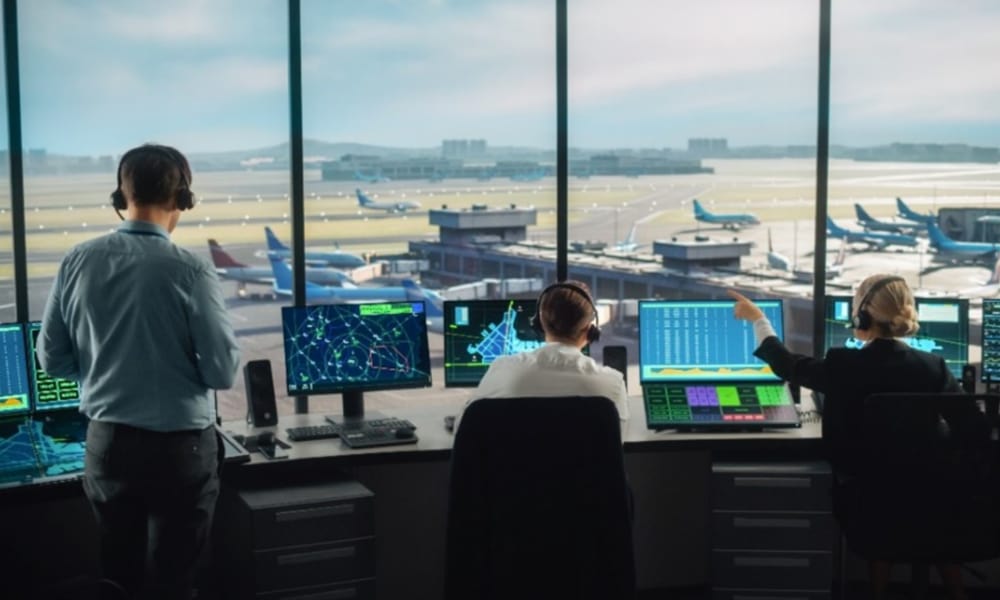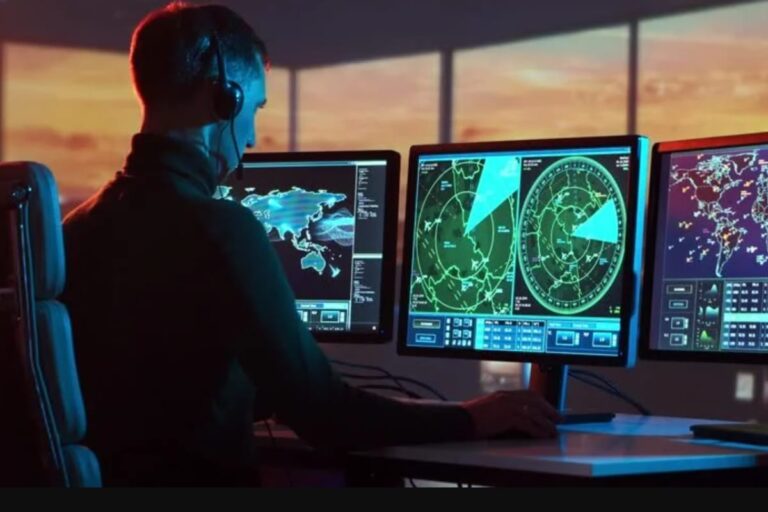What Does ATCM Stand For in Aviation? Aviation runs on clear communication. Controllers, pilots, and maintenance professionals speak a common language built on technical terms and abbreviations. Understanding these terms helps you grasp how the aviation industry works.
Today, we’re breaking down one crucial acronym that keeps aircraft safe in the sky: ATCM. You’ll learn what it means, how it works, and why it matters for every flight operating in controlled airspace.
What Does ATCM Stand For?
ATCM stands for Air Traffic Control Monitor. This specialized display system ranks among the most important pieces of equipment in aviation safety.
Controllers use these monitors as their primary visual interface to manage aircraft within airspace systems. Without ATCM displays, modern air traffic control wouldn’t function.
These monitors must provide accurate color distinction between different aircraft. They show route indicators clearly. Controllers rely on this visual information when managing complex airspace situations.
Modern ATCM systems display real-time radar data, flight trajectories, altitude information, and communication status for multiple aircraft simultaneously.
Technology has evolved dramatically. Early systems used simple radar screens with basic blips. Today’s digital displays process massive amounts of flight data in real time.
The largest screen immediately in front of the controller is the main situational display, essentially the radar screen showing different aircraft in their geographical position in relation to airspaces and other traffic.
Controllers can interact with aircraft labels, enter notes about clearances, and display instructions directly on screen.
Private aviation benefits from this technology too. Corporate flight departments coordinate fleet movements using ATCM systems. Business jets like Gulfstream, Bombardier, and Cessna all appear on these displays. The system enhances safety and operational efficiency for every aircraft type.

What Does ATC Mean in Aviation?
Before diving deeper into ATCM technology, let’s clarify what ATC means. What did ATC stand for? Air Traffic Control. ATC is the entire system responsible for directing aircraft flow through controlled airspace. This system serves all aircraft types: commercial carriers, private planes, corporate jets, and military aircraft.
ATC enforces traffic separation rules. Safe distances must be maintained around each airplane at all times. The system operates 24/7 across the United States. Thousands of flights get managed daily. This demonstrates the massive scale of air traffic management responsibilities.
Core ATC Responsibilities
Controllers handle multiple critical tasks. Aircraft separation management tops the list. Controllers ensure safe separations throughout all flight stages. From taxiing to cruising altitude, they monitor spacing constantly.
Flight path coordination keeps traffic flowing smoothly. ATC guides aircraft along pre-established routes. They optimize traffic flow while minimizing delays. Route planning happens continuously as conditions change.
Weather advisory services protect aircraft from hazards. Controllers issue current weather information. They suggest routing alternatives when storms threaten flight paths. This real-time guidance helps pilots avoid dangerous conditions.
Emergency response coordination becomes crucial during crises. ATC clears airspace when problems occur. They liaison with emergency services. Quick decisions during emergencies can save lives.
Ground movement control manages airport surfaces. Controllers direct airplane movement on taxiways and runways. This prevents collisions on the ground where visibility can be limited.
What Are the Three Types of ATC?
Air traffic control divides into three main categories. Each handles specific phases of flight.
Tower Control manages airport operations. These controllers work in the tall tower buildings you see at airports. They handle takeoff and landing clearances. Ground traffic management falls under their responsibility. Visual observation combines with radar data for surface operations.
At larger airports, Surface Movement Radar (SMR) such as ASDE-X displays the location of aircraft and vehicles on the ground, used by ground controllers as an additional tool to track ground traffic particularly at night or in poor visibility.
Approach and Departure Control handles transitioning aircraft. These controllers manage planes arriving at airports. They also handle departing aircraft after tower hands them off. This middle phase connects tower control with en route control. Terminal Radar Approach Control facilities (TRACONs) provide this service.
En Route Control manages high-altitude flight. Also called “Center,” these facilities handle aircraft cruising cross-country. Controllers work in Air Route Traffic Control Centers (ARTCCs). They divide airspace into sectors for better management. Each sector has dedicated controllers monitoring traffic.
Additional specialized services exist. Terminal radar facilities provide precision guidance. Oceanic control manages flights over water where radar doesn’t reach. Military airspace coordination ensures civilian and military aircraft operate safely together.
How ATCM Systems Work
Understanding ATCM technology reveals the sophistication behind air traffic management.

Technology Components
Radar systems form the foundation. Ground-based radar detects aircraft positions. This data feeds into the ATCM display system. Digital displays show processed information clearly.
ScioTeq displays feature the latest display technologies to ensure unique image quality with high optical performance, high contrast, brightness uniformity, and wide viewing angle. Seven out of ten ATC displays worldwide at major airports use advanced display technology.
Color-coded indicators differentiate aircraft. Each plane gets a unique symbol. Different colors show different flight characteristics or alert levels. Real-time data processing updates constantly. The system handles vast amounts of information without lag.
Communication status tracking shows which aircraft controllers can contact. There will be a data block associated with your aircraft’s location on the screen that moves as the aircraft moves through the airspace, including the aircraft call sign, altitude, groundspeed, destination airport and aircraft type.
Visual Interface Features
Aircraft identification markers appear as symbols on screen. Flight route displays show planned paths. Altitude information appears in the data block next to each aircraft symbol. The altitudes are rounded to the nearest 100 feet, with Mode C transponder or ADS-B providing the data.
Speed indicators help controllers predict aircraft positions. Conflict alerts warn when planes get too close. The system highlights potential problems before they become dangerous. In enroute radar displays, “CA” stands for conflict alert.
Emergency codes trigger special displays. If an extenuating circumstance requires you to squawk one of the special transponder codes, your aircraft data block will be highlighted with special codes, such as red letters “EM” standing for emergency above the data block.
Integration with Other Systems
Weather radar connects to ATCM displays. Many approach radar systems display real-time precipitation and intensity levels on the screen in relation to aircraft location. Controllers see storms and can route aircraft around them.
Flight plan databases feed destination information. Controllers know where every aircraft is heading. Emergency alert systems connect directly to displays. All critical information appears in one place.
Over many years, a square 2K x 2K monitor with a 28.1 inch screen size has become the control screen of choice for airspace control and monitoring, usually with high-resolution native 2048 x 2048 screen with a pixel pitch of 0.246mm. This specialized equipment ensures controllers see every detail clearly.
What Is an ATC Flight Delay?
ATC flight delays frustrate passengers. Understanding why they happen helps manage expectations.

Definition of ATC Delays
An ATC delay occurs when air traffic management slows or stops aircraft movement. Traffic management delays happen when too many planes want to use the same airspace. Spacing requirements force controllers to spread out arrivals. Capacity constraints limit how many planes can operate simultaneously.
Common Causes
Weather causes most delays. Studies show more than 70% of air traffic delays stem from adverse weather conditions. Europe experienced a 40% increase in weather-related en route delays in 2024 compared to 2023. Thunderstorms, low visibility, and snow all reduce airport capacity.
Airport congestion creates delays even in good weather. Major hubs reach saturation during peak times. Think of delays like rush hour at JFK or heavy congestion surrounding events like Teterboro before and after the Super Bowl. More planes want to land than the airport can handle.
Airspace restrictions limit traffic flow. Special events create temporary flight restrictions. Equipment limitations at facilities reduce capacity. Even unexpected events like runway closures from aircraft mishaps cause delays.
What is EDCT in Aviation?
EDCT stands for Expect Departure Clearance Time. This is a specific time window assigned by ATC for your departure. Most of the time you can depart within plus or minus 5 minutes of your assigned EDCT.

Ground delay programs issue EDCTs to manage demand. When the Airport Arrival Rate (AAR) is reduced by the supporting ATC facility, the Air Traffic Control System Command Center (ATCSCC) in Warrenton Virginia institutes a Ground Delay Program. Aircraft wait on the ground instead of circling in the air.
Flow control measures use EDCTs to meter traffic through congested areas. Airspace Flow Programs identify constraints in the en-route system and distribute EDCTs to meter the demand through the area. This prevents airborne gridlock.
EDCTs can change as conditions improve. When conditions improve or when demand decreases, the ATCSCC begins running compressions causing other EDCT times to change and decrease delays. Filing flight plans early helps get better departure times.
What Are the 4 Threat Levels in Aviation?
Aviation safety relies on threat assessment. The industry uses a four-level framework to evaluate risks.
Level 1: Low Threat represents minimal risk situations. Normal operations with standard separation. Weather is good. Equipment functions properly. Controllers maintain routine spacing.
Level 2: Moderate Threat indicates increased attention needed. Minor weather impacts operations. Slightly reduced spacing requires more focus. Equipment has minor issues but remains functional.
Level 3: High Threat demands immediate action. Severe weather affects multiple sectors. Separation is reduced significantly. Equipment failures compromise backup systems. Controllers coordinate closely to maintain safety.
Level 4: Severe Threat represents critical situations. Life-threatening weather conditions exist. Multiple system failures occur. Emergency responses activate. Ground stops may be implemented. Safety becomes the only priority.
Controllers use these threat levels for risk evaluation. They adjust procedures based on threat assessment. Higher threat levels trigger additional safety protocols. Emergency procedures activate at severe threat levels.
What Are the 4 C’s of Aviation?
Aviation professionals follow four fundamental principles known as the 4 C’s.
Communication forms the foundation. Clear pilot-controller exchanges prevent misunderstandings. Standard phraseology ensures everyone speaks the same language. Radio procedures follow strict protocols. Miscommunication can cause accidents.
Coordination keeps the system running. Different ATC facilities must work together seamlessly. Controllers pass aircraft between sectors smoothly. Multi-agency cooperation happens during emergencies. Military and civilian operations coordinate constantly.
Compliance maintains safety standards. Regulatory adherence isn’t optional. Federal aviation regulations protect everyone. Standardization procedures ensure consistency across the system. Every pilot and controller follows the same rules.
Crew Resource Management emphasizes teamwork. Controllers don’t work alone. Teams coordinate complex operations. Professional standards guide decisions. Training emphasizes working together effectively.
Read Also: F-16 Ride Along: Your Complete Guide to Flying in a Fighter Jet
Importance of ATCM for Different Aircraft
ATCM systems serve all aviation sectors equally.
Commercial Aviation
Airlines depend on ATCM for heavy traffic management. Scheduled operations require precise coordination. Controllers use these displays to manage hundreds of aircraft daily at major hubs. The system prevents delays when possible and manages them when necessary.
Private and Corporate Jets
Business aviation benefits significantly from ATCM technology. Cessna Citation operators file flight plans that appear on controller screens. Bombardier Global fleet movements get coordinated through the same system. Gulfstream jets flying coast-to-coast receive routing from controllers watching ATCM displays.
Corporate flight departments rely on this infrastructure. They need flexible scheduling. Controllers accommodate their needs while maintaining safety. The system works because everyone uses the same technology.
Understanding Benefits
Safety comes through systematic supervision. Controllers watch every aircraft constantly. The visual interface makes threats obvious. Quick responses prevent problems.
Efficient airspace utilization saves money. More efficient ATC could save 5-10% of aviation fuel by avoiding holding patterns and indirect airways. Controllers optimize routes when possible. Direct routing reduces flight times.
Reduced operational costs benefit operators. Less fuel burned means lower expenses. Shorter flight times increase aircraft utilization. These savings matter for corporate operators watching budgets.
Professional Pilots Perspective
Pilots interface with ATC systems constantly. They understand controllers are watching on ATCM displays. Communication protocols exist for good reasons. Situational awareness improves when everyone knows what others see.
Read Also: What is FBO in Aviation: Your Complete Guide to Fixed-Base Operators
ATCM Technology Evolution
The journey from early radar to modern displays shows remarkable progress.
Historical Development
Early radar systems showed basic blips on screens. Controllers identified aircraft through radio communication. Position updates came slowly. The system worked but had limitations.
Analog technology gradually improved. Better screens showed more detail. Color displays differentiated aircraft types. Computer integration began processing more data.
Digital transition revolutionized air traffic control. Processing power increased dramatically. Display resolution improved. More information could be shown without cluttering screens.
Current Technology
Modern EIZO ATC monitors equipped with Intelligent Display Platform (IDP) enable simultaneous display of video signals from up to four independent sources. Controllers customize their workspace. Multiple data feeds appear on single screens.
Automated conflict detection warns of potential problems. The system calculates if aircraft paths will intersect. Alerts appear before situations become dangerous. Controllers can intervene early.
Data processing improvements handle more traffic. The system tracks thousands of aircraft simultaneously. Updates happen in real-time with no lag. Reliability has increased significantly.
Future Capabilities
AI integration shows promise. Machine learning could predict traffic flow issues. Automated systems might suggest optimal routing. Controllers would still make final decisions but with better information.
Enhanced safety features continue development. Better weather integration could happen. Predictive capabilities might forecast problems earlier. The goal remains preventing accidents before they occur.
Improved efficiency benefits everyone. Faster processing enables tighter spacing safely. More aircraft could operate in the same airspace. Delays might decrease while safety improves.
Safety and Efficiency Impact
ATCM systems deliver measurable benefits to aviation.
Safety Enhancements
Mid-air collision prevention is the primary goal. The system ensures aircraft maintain separation. Controllers see potential conflicts developing. Immediate action prevents accidents.
Systematic aircraft separation follows proven procedures. Minimum distances between planes are never violated. The ATCM display shows exactly where every aircraft is. Controllers maintain these separations constantly.
Emergency response capability saves lives. When problems occur, controllers see them immediately. They clear airspace for emergency aircraft. Coordination with rescue services happens quickly. During peak air travel times in the United States there are about 5000 airplanes in the sky every hour, translating to approximately 50000 aircraft operating daily. Managing this safely requires robust systems.
Weather hazard avoidance protects passengers. Controllers route aircraft around dangerous weather. ATCM displays show storm locations clearly. Pilots receive timely warnings about turbulence and icing.
Operational Efficiency
Reduced holding patterns save fuel. Controllers sequence arrivals to minimize circling. Aircraft fly more direct routes to destination airports. Time savings benefit passengers.
Optimized flight routes cut costs. When airspace allows, controllers provide direct routing. Fuel consumption decreases. Flight times shorten. These efficiencies add up across thousands of daily flights.
Schedule reliability improves with good ATC. Airlines can maintain on-time performance when systems work well. Corporate jets meet tight executive schedules. Predictable operations help everyone plan better.
Maintenance Requirements
Equipment reliability matters tremendously. ATCM systems cannot fail without backup. Regular maintenance prevents problems. Updates and upgrades keep technology current.
Controller training ensures proper system use. Understanding the technology is essential. Ongoing education keeps skills sharp. Professional development maintains high standards.
Regulatory Compliance Through ATC
Air traffic control enforces aviation regulations.
Federal aviation regulations get enforced through ATC. Controllers verify aircraft meet requirements. Proper certifications must be current. Equipment must function correctly. The system protects everyone by ensuring compliance.
International standards apply across borders. Controllers worldwide follow similar procedures. Communication works because everyone uses standard phraseology. Aircraft crossing international boundaries receive consistent service.
Aircraft certification gets verified through the system. Controllers know which aircraft can operate in which conditions. Restrictions appear in flight plan systems. Standardized procedures prevent confusion.
Communication protocol consistency helps pilots flying different aircraft types. Whether you’re flying a small Cessna or a large Bombardier, ATC procedures remain the same. This standardization makes operations safer and more efficient.
FAQs About ATCM in Aviation
What does ATCM stand for in aviation?
ATCM stands for Air Traffic Control Monitor. These are specialized display systems used by air traffic controllers to manage aircraft within airspace systems. The monitors show real-time radar data, flight paths, altitudes, and communication status for multiple aircraft simultaneously. They serve as the primary visual interface between controllers and the aircraft they manage.
How do air traffic controllers use ATCM displays?
Controllers watch ATCM displays constantly while managing their assigned airspace. The screens show aircraft positions geographically with data blocks containing call signs, altitudes, speeds, and destinations.
Controllers interact with the display to enter clearances and instructions. They monitor for potential conflicts and use the information to maintain safe separation between aircraft. Multiple screens typically surround each controller position showing different information types.
What information appears on an ATCM screen?
ATCM displays show aircraft symbols with associated data blocks. Each block contains the aircraft call sign, current altitude, groundspeed, and destination. Route information appears as lines showing planned flight paths.
Weather radar overlays show precipitation and storms. Airspace boundaries, airports, and navigation fixes appear as reference points. Special codes highlight emergency aircraft or other situations requiring immediate attention. The display updates in real-time as aircraft move.
Why are ATCM monitors so expensive and specialized?
Aviation-grade ATCM monitors must meet extremely high reliability standards. They operate 24/7 without failure in mission-critical environments. Color accuracy must be perfect for distinguishing different aircraft indicators.
High resolution shows fine details clearly. Brightness needs to work in varying lighting conditions. These monitors often use square 2048 x 2048 pixel displays rather than standard rectangular formats. Certification requirements add costs. The specialized nature and small production volumes increase prices significantly.
Can pilots see what controllers see on ATCM displays?
No, pilots don’t have direct access to ATC display screens. However, pilots can request traffic information and controllers will describe what they see. Modern cockpit displays show some similar information through systems like ADS-B traffic, but this differs from full ATC displays.
Some aviation enthusiasts use flight tracking websites that approximate what controllers see, though these public displays lack the detail and real-time precision of actual ATCM systems.
Conclusion
Air Traffic Control Monitors serve as the essential visual interface between controllers and aircraft. These sophisticated displays enable safe, efficient operations within our airspace system.
For aviation professionals, pilots, and anyone interested in how aircraft stay safe, understanding ATCM technology reveals the complexity behind every flight.
The next time you board an aircraft, remember that controllers are watching your plane on these specialized displays, ensuring your safe passage through the sky. That’s what ATCM stands for in aviation—the technology that makes modern air travel possible. For more information, visit Crew Daily.


